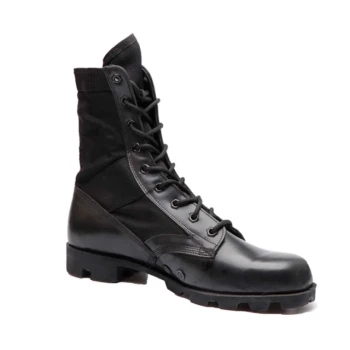Every year, electrical hazards cause thousands of workplace injuries—many fatal. The right safety footwear can mean the difference between a close call and a catastrophic incident. Electrical Hazard (EH) boots use advanced dielectric materials and rigorous engineering to interrupt dangerous currents before they reach the worker.
This article breaks down:
- The science behind non-conductive materials that block electricity
- How EH boots perform in real-world scenarios (backed by documented cases)
- What ASTM F2413-18 EH certification truly guarantees
- Key selection and maintenance practices for long-term protection
Electrical Hazard Boots: A Lifesaving Barrier Against Electricity
The Science Behind Non-Metallic, Dielectric Materials
EH boots rely on dielectric insulation—materials that resist electrical conductivity—to create a protective barrier. Unlike standard work boots, which may contain metal shanks or conductive stitching, EH designs use:
- Rubber soles: Natural or synthetic rubber compounds block current flow due to their high electrical resistance.
- Composite materials: Fiberglass or carbon-fiber reinforcements replace metal components in toe caps or midsoles.
- Sealed construction: Stitching and eyelets are coated or designed to prevent moisture ingress, which could compromise insulation.
Did you know? The same principle that keeps your feet warm in winter boots (trapping heat via non-conductive insulation) also applies to EH boots—except they’re trapping electricity outside the boot.
How EH Boots Interrupt Electrical Currents in Real-World Scenarios
EH boots are engineered to handle two critical threats:
- Direct contact with live wires: Dielectric soles prevent current from passing through the body, even when stepping on a 14,000-volt source.
- Ground faults: By resisting conductivity, the boots stop electricity from using the worker’s body as a path to the ground.
Case in point: Workers in industrial settings (e.g., utility linemen or factory technicians) have avoided fatal injuries when their EH boots withstood accidental contact with high-voltage equipment. Testing shows certified boots can endure up to 18,000 volts for 60 seconds without leaking harmful current.
Industry Standards and Testing: What "ASTM F2413-18 EH" Really Means
The ASTM F2413-18 EH standard isn’t just a label—it’s a rigorous validation of a boot’s ability to protect against electrical shocks. Key requirements include:
- Voltage resistance: Boots must block at least 18,000 volts under controlled dry conditions.
- Leakage limits: Current flow can’t exceed 1.0 milliampere (mA)—far below the 50 mA threshold that can stop a human heart.
- Durability checks: Soles must resist punctures or wear that could expose conductive materials.
Pro tip: Look for the "EH" marking on the tongue or sole. Boots without this certification may lack tested dielectric properties.
Case Study: Preventing Arc Flash Injuries in Industrial Settings
Arc flashes—explosive discharges of electricity—pose another lethal risk. While EH boots aren’t arc-rated by default, their non-conductive materials reduce injury severity by:
- Preventing current from entering through the feet.
- Melting less violently than conductive materials during extreme heat.
Documented cases show workers escaping with minor burns because their EH boots didn’t ignite or transfer current during arc events.
Choosing and Maintaining EH Boots for Long-Term Protection
Selection Criteria
- Prioritize ASTM F2413-18 EH compliance over generic "electrical resistance" claims.
- Opt for oil-resistant soles if working in wet or greasy environments.
- Ensure a snug fit—loose boots can compromise the dielectric seal.
Maintenance Musts
- Inspect soles weekly for cracks, punctures, or excessive wear.
- Keep boots dry; moisture can degrade insulation over time.
- Replace immediately if exposed to a severe electrical incident (even if no damage is visible).
Ready to equip your team with certified EH boots? 3515 manufactures rigorously tested electrical hazard footwear for bulk buyers and distributors. Our ASTM-compliant designs combine advanced dielectric materials with industrial durability—because safety shouldn’t be a compromise. [Contact us] to discuss your procurement needs.
Related Products
- Wholesale Customizable Suede Safety Boots - Puncture-Proof with Velcro Closure
- Wholesale Modern Comfort Shoes with Dial Closure for Private Label & Bulk Orders
- Durable Military Combat Boots with Water Drainage for Wholesale & OEM
- Wholesale Leather Ankle Boots with Lug Soles for Custom Brand Manufacturing
- Wholesale Classic Leather Lace-Up Ankle Boots for Brand Manufacturing
Related Articles
- How to Choose Work Boots That Balance Safety, Comfort, and Durability for Your Job
- Matching Men’s Work Shoe Safety Technologies to Workplace Hazards
- Work Boots vs. Western Boots: How to Choose the Right Footwear for Labor Safety
- How to Choose Work Boot Materials for Maximum Safety and Durability
- How to Extend Work Boot Lifespan: Science-Backed Care for Safety & Savings

















